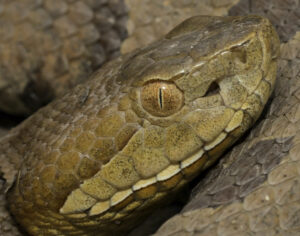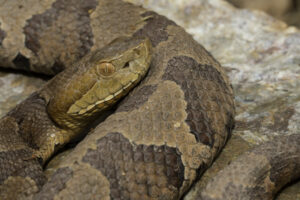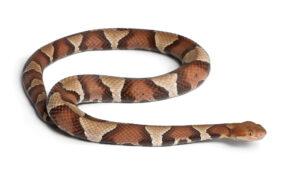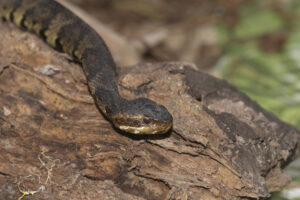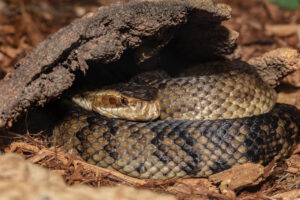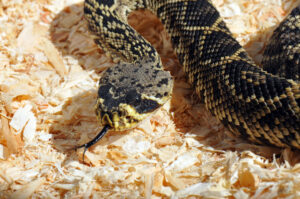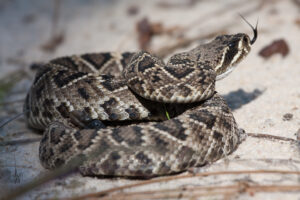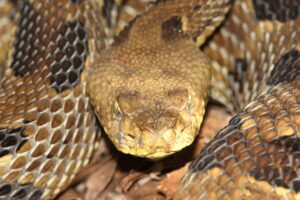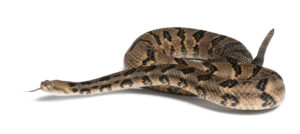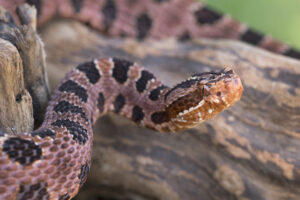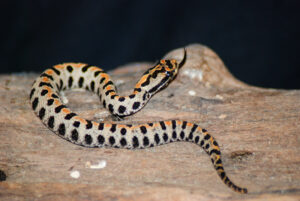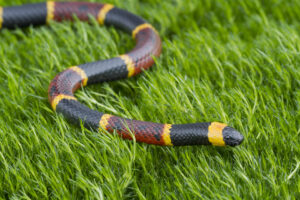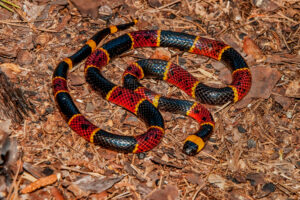Dogs and snakes aren’t always a good combo. The warmer temperatures in spring and summer bring out more people, their pets, and snakes. More than 30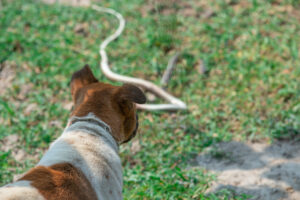 different species of snakes live in North Carolina. Most live in wooded areas, but they can also be present in your own backyard. Many of them are harmless, like the little eastern worm snake, which is the most common snake in North Carolina and will not bite. But there are six types of venomous snakes in our state that do bite and can be dangerous for you and your pet.
different species of snakes live in North Carolina. Most live in wooded areas, but they can also be present in your own backyard. Many of them are harmless, like the little eastern worm snake, which is the most common snake in North Carolina and will not bite. But there are six types of venomous snakes in our state that do bite and can be dangerous for you and your pet.
It can sometimes be a challenge to tell which snakes are venomous and a greater threat to your dog or cat. Read on to find out what to do after a snake bite and to learn the characteristics of the most venomous snakes closest to your home.
Venomous Snake Bites are a Medical Emergency
The six types of venomous snakes found in North Carolina include the copperhead, the cottonmouth (also called water moccasin), the eastern diamondback rattlesnake, the timber rattlesnake, the pigmy rattlesnake, and the eastern coral snake. The copperhead is the most common snake to see in our state while the coral snake is extremely rare. Bites from rattlesnakes are more severe than bites from copperhead or cottonmouth snakes and are considered an even more dire emergency.
Except for coral snakes, all of these snakes can be recognized by the following features:
1) Vertical, slit-like pupils
2) Triangular or diamond-shaped heads
3) Big, fat bodies
4) Pits between their eyes and nostrils for sensing heat
If you see one of those snakes, leave it alone and quickly walk away, giving it plenty of space. If a venomous snake bites your pet, the most important thing to do is seek medical attention right away!
How Harmful are Snake Bites? It Depends on the Snake.
Knowing what species of snake did the biting is the best route to diagnosing snake bites on dogs. Try to take a photo on your phone of the snake who bit your dog or at least provide a good description of it, including colors and patterns on the snake’s skin. A non-poisonous bite can still become infected, so you’ll want to contact your veterinarian as soon as possible if your dog has been bitten by any snake.
For cats, it’s likely you may not witness the attack so check for bite marks if your pet is acting strangely. Venomous snake bites typically appear as two puncture marks. This type of bite will most likely be accompanied by pain and swelling
A venomous snakebite is obviously more of a medical emergency for dogs and cats than a bite from a garter snake. Bites attended to very quickly are treatable the vast majority of the time, but in some instances, they can be fatal or cause the loss of a limb. According to one leading veterinary expert, about 20% of bites by venomous eastern diamondback and eastern coral snakes are fatal for dogs. So, while the odds are very good for a full recovery from a bite, avoidance should be the goal of every dog, cat, and pet parent.
The danger of a snakebite is dependent on multiple variables including things like:
- The size of your dog or cat
- The species and age of the snake
- The depth of the fang penetration
- The amount of venom injected
- The location of the bite
The good news about snakes is that most of the time they just want to be left alone. But if your dog or cat is sticking their nose in the wrong place at the wrong time—under a log, rock, bush, or pile of leaves—a disturbed snake can strike suddenly and fiercely. Avoiding these types of hiding spots can protect your pet from snakes.
What Should You Do If a Snake Bites Your Dog or Cat?
If you suspect that your canine or feline family member has been bitten by a snake, you will need to get them medical attention immediately! Minutes count for more serious bites. There are many “do’s” if your pet is bitten by a snake, but there are also a few “don’ts.”
The “don’ts” include:
1) Do NOT try to suck venom from the wound site.
2) Do NOT try to grab the snake, as you risk getting bitten yourself!
Here are the “do’s”:
1) Try to identify or take note of the snake’s coloring, patterns, and size so you can inform your veterinarian.
2) If your pet has been bitten on a leg, wrap a constricting band (or t-shirt) just above the bite site and snug enough (but not excessively tight) to slow the spread of the venom. Your pet may lose a leg, but the band may save its life.
3) Quickly scan your pet’s body for any additional fang marks to determine if there are any other limbs that might need a wrap.
4) Go to the nearest animal hospital immediately!
Non-venomous snake bites can also be harmful to animals. Even if your dog was bitten by a common garden snake, you’ll want to have them treated because the bite wound can still become infected. Snake bites on cats are not very common, but you will still need to bring in your kitty so they have the best chance of recovery. Most pets will recover with prompt and appropriate treatment, so don’t waste any time calling your vet.
How a Snake Bite is Usually Treated
Treatment varies according to what type of snake has bitten your pet. Different dogs may also have different reactions to a snake bite depending on where they are bitten. Non-venomous snakebites are generally treated with wound cleaning, antibiotics, antihistamines and anti-inflammatory medications as indicated. Harmony takes a broad-based approach of diagnostic tests, such as blood work, to check organ function and clotting abilities followed by supportive care for the specific needs of the patient, which may or may not include antivenom. A veterinarian will counteract neurotoxic and hemotoxic venoms with IV fluids, pain medication, and antivenoms if needed. Antivenoms are often specific to particular snakes and therefore, not all hospitals carry all types at all times.
Best Practices for Avoiding a Snake Encounter
Keeping your pet on a shorter leash, staying on open paths for good visibility of potential snake appearances, and not letting your pet explore holes in the ground, or dark or covered areas, are all ways to prevent snake encounters. Off-trail hiking with an unleashed dog is not recommended as your dog could flush out a snake that could make you both vulnerable to a bite. If you hear a rattle, stay away! Keep in mind that rattlers are nocturnal most of the year, so be especially careful if you are on a night walk where rattlesnakes live. Finally, if your dog or cat seems particularly curious about something in a tall grassy area, pull them away until you are confident a snake is not present.
It’s also a good idea to keep your own grass short and keep your lawn tidy. Eliminate brush, tools, toys, and rock piles which all make excellent snake hiding spots. Don’t store items in your yard or garage which attract rodents, which in turn attract snakes, such as food, fruit, and birdseed.
Getting Your Pet to a Vet is Critical
As it’s not always possible to keep dogs, cats and snakes apart, know where you can take your pet in an emergency. At Harmony Animal Hospital in Apex, NC, we’re here to treat your pet in an emergency and to answer your questions about keeping your dog and cat safe from snakes and any other outdoor risks you might encounter. We love your furry friends as much as you do and want to ensure their safety from snakes. Harmony Animal Hospital can be reached at (919) 303-3456.
Know Your North Carolina Venomous Snakes
Here’s a guide to help you quickly identify venomous snakes in our area.
- Copperhead
Copperheads are the most common venomous snakes in North Carolina. They are brownish/copper in color with an hourglass pattern. As a baby, this snake might have either a yellow or green tail tip which goes away after about a year. Average adult size is 2-3 feet long.
- Cottonmouth (Water Moccasin)
Cottonmouth snakes have dark brown or olive skin with a pattern of dark bands (sometimes yellow) on their body. Younger cottonmouth snakes are usually lighter brown in color with a more striking pattern on their bodies. Their name comes from the cotton/white coloration inside their mouth. They prefer freshwater environments but can occasionally be found on land. Average adult size is 2-4 feet long.
- Eastern Diamondback Rattlesnake
The eastern diamondback rattlesnake is gray or yellowish in color and has a dark diamond pattern outlined in black. They have large heads with two lines on their face. They are known for making a rattle sound. Average adult size is 4-5 feet in length.
- Timber Rattlesnake
The timber rattlesnake varies in color but has lighter skin and dark bands with a rattle on the end of its tail. Coastal varieties have a brown or orange stripe down the middle of their backs. Average adult size is 3-4 feet long.
- Pigmy Rattlesnake
The pigmy rattlesnake is gray, pinkish or reddish in color with a dark, spotted pattern on its body. Their rattle is more of a small buzzing sound. They grow to only about 1-2 feet long and mainly live in forests.
- Eastern Coral Snake
Coral snakes are rarely seen in North Carolina and are actually considered endangered. They are slender with red, yellow, and black rings. Coral snakes live in sandy areas and often stay underground. Average adult size is 1.5-2.5 feet long.


